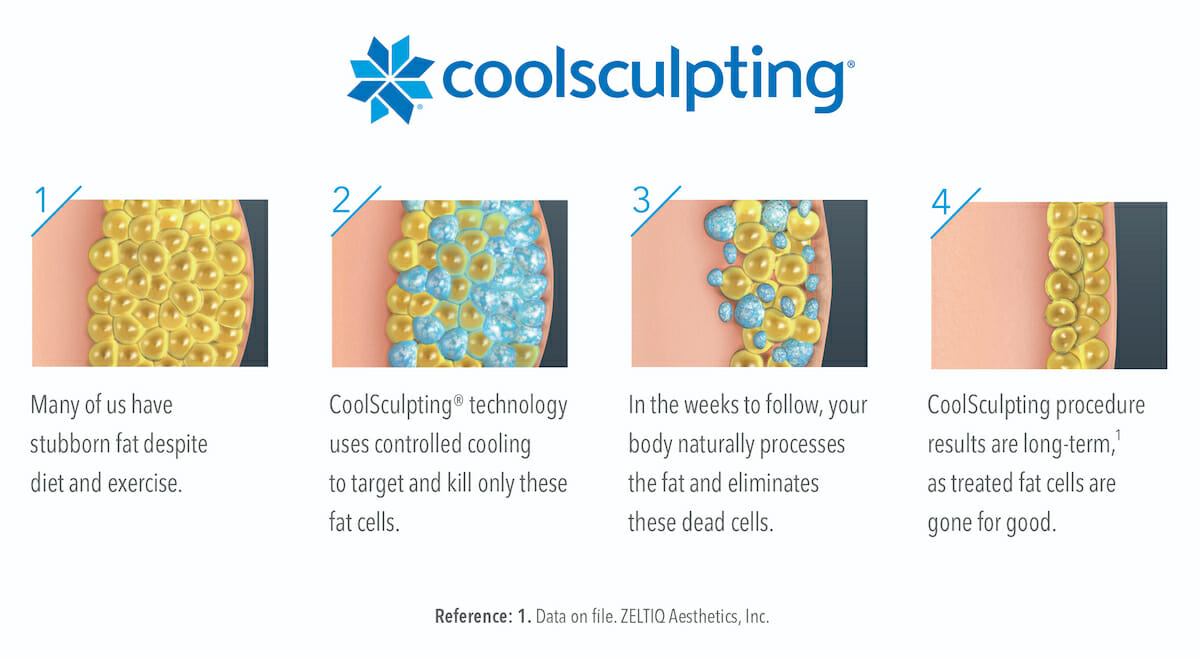Yikes—a new year is upon us and the commercials for weight loss programs will be overwhelming our airwaves (ugh!). Many of us have thought about the CoolSculpting, or cryolipolysis procedure. It is a cosmetic treatment that removes excess fat in stubborn areas. It works by freezing fat cells, killing and breaking them down in the process.
CoolScuplting is a fat reduction method that targets fat in body areas that are more challenging to remove through diet and exercise. It carries fewer risks than traditional fat reduction methods such as liposuction. However, while it is mostly safe, it is important for people to be aware of some potential side effects.
CoolSculpting is a non-invasive procedure, meaning it does not involve cuts, anesthesia, or instruments entering the body. It was the most used body sculpting procedure in the United States in 2018.
What is CoolSculpting®?
CoolSculpting is a branded form of fat reduction method called cryolipolysis. It has Food and Drug Administration (FDA) approval. As with other forms of cryolipolysis, it uses freezing temperatures to break down fat cells. Fat cells are more affected by cold temperatures than other cells. This means that the cold does not damage other cells, such as the skin or underlying tissue.
During the procedure, the practitioner vacuums the skin above the area of fatty tissue into an applicator that cools the fat cells. The cold temperatures numb the site, and some people report feeling a cooling sensation. Most CoolSculpting procedures take around 35–60 minutes, depending on the area a person wishes to target. There is no downtime because there is no damage to the skin or tissue. Some people report soreness at the site of CoolSculpting, similar to that they might have after an intense workout or minor muscle injury. Others report stinging, firmness, mild discoloration, swelling, and itchiness. After the procedure, it may take around 4–6 months for the fat cells to leave a person’s body. In that time, the area of fat will decrease by an average of 20%.
How much does CoolSculpting cost?
According to CoolSculpting®, the typical cost of its treatment ranges from $2,000–4,000. However, areas that require small applicators, such as the chin and jaw, may range between $700–900.
The American Society of Plastic Surgeons 2020 statistics report shows that the national average cost for noninvasive fat reduction procedures is $1,437. Prices vary depending on the number of treatments and the areas an individual wants to treat: The bigger the area, the more expensive the treatment is.
It is also sensible for a person to consider the number of treatments necessary. Areas with more fat may require more treatments. Factors such as geographic location and the skill of the treatment provider may also influence the cost.
CoolSculpting is a cosmetic procedure that does not treat an underlying health condition, so insurance does not typically cover the costs.
Does CoolSculpting work?
CoolSculpting and other forms of cryolipolysis have a high success and satisfaction rate. However, people should note that the effects of the treatment only apply to the targeted areas. It also does not tighten the skin.
Moreover, the procedure doesn’t work for everyone. It works best on people near the ideal body weight for their build with pinchable fat on stubborn areas. A 2017 study notes that the procedure was effective, especially in those with lower body mass. Lifestyle and other factors may also play a role. CoolSculpting is not a weight-loss treatment or a miracle cure for an unhealthy lifestyle. A person who continues with an unhealthy diet and remains sedentary while undergoing CoolSculpting can expect less fat reduction.
Results
CoolSculpting effectively removes areas with stubborn fat. The body removes the frozen and broken down fat tissues within 4–6 months. The procedure also delivers lasting results. It destroys fat cells, so they will not return.
What does the research say?
A 2015 review in Plastic and Reconstructive Surgery analyzed 19 previous studies of cryolipolysis. Research generally points towards CoolSculpting being a relatively safe and effective treatment for removing some areas of fat.
A 2020 study found that cryolipolysis that uses new and better-fitting applicators are safe and effective in quickly reducing excess fat in various body areas.
However, a 2020 review notes that people with cold-induced conditions such as Raynaud’s disease and skin disorders should not undergo the procedure.
A 2015 study also found that cryolipolysis resulted in more fat reduction than ultrasound.
Side effects and complications of CoolSculpting
Cryolipolysis is a non-invasive procedure, so it does not require cuts, anesthesia, or medications that could cause an allergic reaction. This means that the rate of complications and side effects is lower than with more invasive procedures, such as liposuction.
Analysis in the Aesthetic Surgery Journal found that, of 1,445 people, only 12 people—fewer than 1%—reported complications. The most common complication was less sensation in the treated area than beforehand.
Other complications may include:
swelling
bruising
sensitivity
redness
localized pain
A 2015 review found no serious complications, such as bleeding, skin pigment changes, or scarring.
A 2021 study found that paradoxical adipose hyperplasia (PAH) happens in 0.05–0.39% of cases. PAH is a condition whereby instead of destroying fat in the treated area, the fat grows larger than before treatment. PAH is rare and can be treated with traditional liposuction. However, this is more common in older units and applicators and on certain people with characteristics that predispose them to the condition. This includes being male and having increased testosterone levels.
How long does CoolSculpting last?
CoolSculpting destroys fat cells, and those particular cells will not return. A 2016 study even found that the effects can last from six to nine years. Destroying existing fat cells will not prevent new fat cells from appearing. This is why a healthy lifestyle is vital to preserving the results of CoolSculpting. A person who does not exercise or follow a healthy diet may soon see fat building up again.
Alternatives to CoolSculpting
There are other types of fat reduction methods aside from cryolipolysis.
Coolsculpting vs. liposuction – For people who want more rapid results in a single treatment, liposuction may be a better option. However, liposuction is more invasive, so it carries a much higher risk of complications than cryolipolysis. A 2017 study found that liposuction alone had a 0.7% major complication rate, but this risk increases with combined procedures.
CoolSculpting vs. Kybella® – Kybella is a branded form of injection lipolysis. It uses an injection to destroy submental fat or fat under the chin. While CoolSculpting is noninvasive, Kybella is minimally invasive and may injure nearby structures, causing marginal mandibular nerve injury causing an asymmetric smile and dysphagia, or difficulty swallowing.
CoolSculpting vs SculpSure® – SculpSure is another non-invasive fat reduction method. It uses laser lipolysis or heat-based laser to “melt” fat cells. Compared to CoolSculpting, SculpSure sessions are faster, with an average of 25 minutes, and can cover multiple areas at once. The two procedures have similar downtime, pain level, side effects, and potential risks.
CoolSculpting vs. Vanquish® – Vanquish is a type of radiofrequency lipolysis which uses radio waves to kill fat cells. A 2020 study found that Vanquish effectively reduces a person’s fat, body mass index (BMI), and abdominal circumference.
The bottom line
CoolSculpting is an effective fat reduction method. However, it does not apply to all and will not address the underlying cause of unwanted fat. People undergoing the procedure should couple it with lifestyle changes to prolong its results.
CoolSculpting is just one option for removing fat. A person should discuss options for fat removal with a doctor and the benefits and risks of these procedures, which may vary between individuals.
Medically reviewed by Catherine Hannan, M.D.
Written by Rachel Ann Tee-Melegrito; Updated on December 16, 2021
Source: https://www.MedicalNewsToday.com
Exclusive content from CARE magazine











